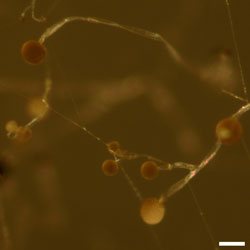
Samples isolated from Chobani yogurt that was voluntarily recalled in September 2013 have been found to contain the most virulent form of a fungus called Mucor circinelloides, which is associated with infections in immune-compromised people.
The study by Duke University scientists shows that this strain of the fungus can survive in a mouse and be found in its feces as many as 10 days after ingestion.
In August and September 2013, more than 200 consumers of contaminated Chobani Greek Yogurt became ill with vomiting, nausea and diarrhea. The U.S. Food and Drug Administration (FDA) analyzed the contaminant and identified it as the mold Mucor circinelloides.
On Sept. 5, 2013, Chobani voluntarily recalled eight product lines that had been distributed nationwide from its Twin Falls, Idaho facility. The facility was shut down and thoroughly cleaned. Chobani said at the time that the mold was naturally occurring and not considered a food-borne pathogen.
This study, which appears July 8 in the online, open access journal mBio, indicates that the particular strain of fungus found in the yogurt may pose a more serious threat to public health than previously thought, said Dr. Joseph Heitman, a senior author of the study and professor and chair of molecular genetics and microbiology at Duke's School of Medicine.
Heitman said the finding also suggests specific attention should be paid to fungal pathogens in food products and the factories that manufacture them.
"Typically when people think about food-borne pathogens, they think about viruses or bacteria, they don't think of fungi," said Soo Chan Lee, a senior research associate at Duke who led this study. "Our research suggests it may be time to think about fungal pathogens and develop good regulations to test them in manufacturing facilities."
The study relied on a sample provided by a Texas couple who became ill with diarrhea and vomiting after eating a casserole made with the recalled product. The couple said the casserole containing the yogurt had been cooked for more than 30 minutes at 350 degrees Fahrenheit. They both reported experiencing diarrhea and the man said he also vomited after eating the casserole a second time.
After learning of the recall, the couple contacted the Heitman laboratory -- which had previously published papers on Mucor circinelloides -- and offered the remaining portion of their yogurt for analysis. They said the tub of plain yogurt had been kept in their refrigerator at 37 degrees Fahrenheit for several days, but it showed half-inch to one-inch colonies growing on its surface. The Heitman lab provided the couple with instructions and a kit to collect swab samples from the yogurt in Texas and then to ship both the swabs and the container cold to North Carolina. Both the swabs and the tub sample produced colonies of the pathogenic mold in the lab.
The Duke researchers isolated Mucor circinelloides from the yogurt container and applied DNA barcoding -- analyzing standardized regions of the fungal genome -- to further identify its exact subspecies. They found it belonged to the most virulent subspecies, Mucor circinelloides forma circinelloides (Mcc).
"There are three closely related species, and one of them we typically find infecting humans," Heitman said. "There was some chance that this yogurt isolate would be the human pathogenic form, and we found that it was."
The researchers then performed a number of experiments to assess the virulence of the fungal contaminant.
When they injected spores from the fungus into the bloodstream of mice via their tail vein, they found it produced a lethal systemic infection in four out of five diabetic mice, which were being used as a model of one of the major risk factors for human infection. However, when they fed spores by mouth to five diabetic mice, the results were less dramatic, resulting in severe weight loss in only one case.
The Duke researchers found that the fungus can survive passage through the gastrointestinal tract of the mice, suggesting it could opportunistically colonize an immune-compromised host.
"We still don't know if the fungus is infecting the gastrointestinal tract, or if it is producing some sort of toxin that makes people sick," said Heitman.
The researchers sequenced the entire genome of the fungus to look for clusters of genes that could produce toxic molecules called secondary metabolites. Although they uncovered a number of candidates, it is still unclear whether the fungus is making any toxins that could explain the symptoms experienced by people who ate the contaminated yogurt.
Heitman's laboratory also tested 16 other samples of Chobani yogurt and did not find Mucor circinelloides in any of them. The researchers asked the FDA for more information on its analyses of the recalled product or access to the samples the agency had obtained, and the agency declined their requests.
This research was supported by the National Institutes of Health (R21 AI085331) and some of the genome sequencing performed for the study was supported by the Human Microbiome Project (U54HG004969).
CITATION: "Analysis of a foodborne fungal pathogen outbreak: virulence and genome of a Mucor circinelloides isolate from yogurt," Soo Chan Lee, R. Blake Billmyre, Alicia Li, Sandra Carson, Sean M. Sykes, Eun Young Huh, Piotr Mieczkowski, Dennis C. Ko, Christina A. Cuomo, and Joseph Heitman. mBio, July 8, 2014. DOI:10.1128/mBio.01390-14